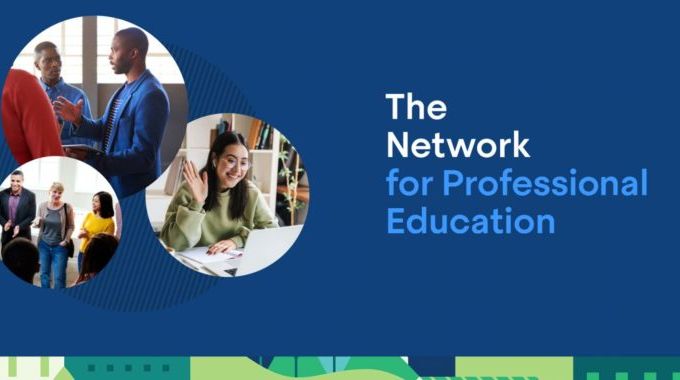Transforming the Large Lecture Course

Using Innovative Concepts and Technology to Make Organizational Behavior Come Alive
It takes vision, hard work, and leadership to make big changes in a mandatory large-lecture undergraduate course. Those same principles are taught in the Boston University Questrom School of Business sophomore course QSB OB 221, “The Dynamics of Leading Organizations.” And they are the hallmarks of what associate professor Jack McCarthy and master lecturer Sandra Deacon Carr brought to the task of making the course truly dynamic for Questrom students.
They recognized that the traditional large lecture format was just not engaging the students. Said McCarthy, “It was a traditional lecture format, where we would herd 400 students into a large lecture hall once a week. Although we were teaching them psychological development, teamwork, and classical theories that were quite meaningful, the format was ineffective as a way to deliver the content.”
Bringing in the Jive
As McCarthy and Deacon Carr and the Organizational Behavior department leadership began considering the structure of the course and how to more effectively reach their goals, they decided to cut back on the number of large lectures, replacing them with lengthier immersive learning discussion sessions in the form of weekly three-hour studio classroom sessions in which students could actively learn through individual and team activities.
In a lecture, you can give students content in context,” explained Deacon Carr, “but you really can’t get them engaged in their own learning and reflecting back on what it is that they’ve learned.”
Building an Interactive Experience

Working cooperatively with the entire OB department to consider the changes they were making, McCarthy and Deacon Carr decided to shake up the remaining large lectures by surprising the students with live performances from jazz musicians, actors, an a cappella troupe, and dancers from BU’s College of Fine Arts that were integrated into the theme and flow of the lecture. After each performance, the artists would sit on the stage and talk about how they share leadership, how they collaborate, and how they solve problems to enable them to complete an effective performance.
Explained McCarthy, “We thought about who really understands teamwork, who really understands diversity and collaboration. And that led us to artists and musicians, dancers, people in the theater group, who were doing this all the time as part of being an ensemble.”
 For example, McCarthy noted that for many years he had concluded his lecture on team dynamics by describing how a jazz troupe improvises. Since renovating OB221, he has actually hidden a BU jazz ensemble behind Questrom’s lecture hall screen. The musicians actually emerge during the lecture to play jazz for the class, and then discuss their own team dynamics with the class.
For example, McCarthy noted that for many years he had concluded his lecture on team dynamics by describing how a jazz troupe improvises. Since renovating OB221, he has actually hidden a BU jazz ensemble behind Questrom’s lecture hall screen. The musicians actually emerge during the lecture to play jazz for the class, and then discuss their own team dynamics with the class.
“The ensemble can demonstrate the concepts much better than I could explain it in the hour lecture I’ve delivered just before,” said McCarthy. “Using musicians to demonstrate the concepts in a real-time, interactive way is often the highlight of the semester.”
 The dance troupe demonstrates and then discusses shared leadership. Said McCarthy, “We actually hid the dancers in the audience, and at the right moment they popped up, came forward, and created an ensemble on stage.”
The dance troupe demonstrates and then discusses shared leadership. Said McCarthy, “We actually hid the dancers in the audience, and at the right moment they popped up, came forward, and created an ensemble on stage.”
The same was done with an a cappella ensemble group. “They showed, literally and figuratively, how leadership is shared during the course of the performance,” McCarthy explained.
Every performance was followed by a discussion, where the performers could talk about how they formed their group, established mutual trust, created diverse groups, and continued to work collaboratively.
McCarthy concluded, “It allowed us to create a lecture series that supported the studio model of the discussion section rather than the reverse, that forced us to think about creating dynamic lectures that were more community-building as well as content-delivering.”
Active Learning Experiments
McCarthy, Deacon Carr, and their section instructors work together as a faculty team to use various active learning strategies to help the students learn more deeply during the weekly classes. For example, the students are divided into small groups and sent into the city with GPS devices, which are programmed with the locations of historic sites. For this assignment, the students are also provided with team-building exercises and puzzles to solve at each site. This strategy for hands-on learning gives students a much deeper understanding of organizational behavior than just reading or listening to lectures.
“My focus is to get the students engaged in really learning on their own and experiencing it so that they’ll remember it for years to come,” said Deacon Carr.
Another innovation is the Virtual Lecture. For these, the faculty manages smaller groups who watch and discuss McCarthy’s lectures, which are simulcast into their classrooms. This enables faculty to work with students interactively around the lecture material. It has also enabled Questrom to accommodate the growing class size in its popular undergraduate program.
Another innovation is the use of video to gain more teaching time and to help students reflect on what they’ve learned. Every semester, the students work in teams for a capstone project where they interview real managers about the real-world challenges of teamwork and management in their companies and organizations today. Students find it remarkable and reassuring that the managers they interview in industry frequently cite the very same lessons about teamwork and leadership that the actors, dancers and musicians raised in their talk-back session at lecture – and these are the very same concepts and lessons that have been covered in the course’s readings and lectures. McCarthy has used a grant from DEI to hire videographers to create a Capstone video that captures the highlights of what students have learned and chronicles how they felt about the process.
Many Benefits to Course Transformation
The transformation of the large-lecture course has required the addition of some new faculty and the willingness among established faculty to change the way they think about teaching. But success breeds excitement, and the changes have yielded many benefits.
For one thing, Questrom School of Business has been able to improve the quality of student learning even as it has had to accommodate rising enrollment. The innovative use of virtual lectures and studio classrooms enables Questrom to accommodate over 500 students per semester.
At the same time, student responses to the course have changed dramatically. While some students find the three-hour classes long, they are learning more and are more engaged.
McCarthy said, “The three-hour lecture isn’t often practiced at the undergraduate level, but we know that having a larger block of time can be effective to teach concepts that are more lasting and that students can apply.” After the course restructuring, he noted, “students could explore in-depth an experiential exercise. They could do much more discovery-based learning, and really hands-on learning, than ever before.”
Deacon Carr acknowledged that it was initially challenge for faculty who are used to more of a traditional model to adapt to this approach. “They have to get used to the idea that their role now is as more of a facilitator of the content,” she said. “A critical success factor in making a major change like this really supporting faculty through the transition and modeling it as well.
“We are making some strides that are important and that can be a model for other courses at the university potentially as well,” said Deacon Carr.
Thanks to the Questrom School of Business
Citations
https://onlinelibrary.wiley.com/doi/10.1002/jls.2015.9.issue-1/issuetoc [Link]
McCarthy, J. and Deacon Carr, S. (2013) Making Movie Magic: The creation and use of video, digital media and short films to enhance learning in the management curriculum, Proceedings of the 40th Organizational Behavior Teaching Conference.
McCarthy, J. and Deacon Carr, S. (2012) Sustaining a Learning Community: Creative Collaboration and Dynamic Learning in Action, Proceedings of the 39th Organizational Behavior Teaching Conference.
McCarthy, J. and Deacon Carr, S. (2011). Igniting Passion and Possibilities: Conflict, Collaboration and Community through Live Stage Performances. In Kane, K. and O’Neill, B. (Eds.), Proceedings of the 38th Organizational Behavior Teaching Conference: 1013-1040.


